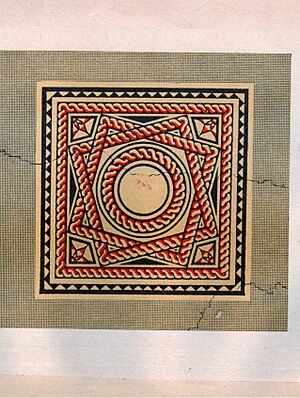Borough Hill Roman villa facts for kids
Quick facts for kids Borough Hill Roman villa |
|
|---|---|

Plan of Borough Hill Roman villa
|
|
| General information | |
| Type | Roman Building |
| Location | At the north end of Borough Hill |
| Country | England |
| Coordinates | 52°15′48″N 1°08′18″W / 52.263422°N 1.138252°W |
The Borough Hill Roman villa is found on the northern part of Borough Hill. This is a large hill near the town of Daventry in Northamptonshire, England. The villa's old remains are inside the walls of an Iron Age fortress. This fort covers the very top of the hill.
A historian and archaeologist named George Baker first found the villa's remains in 1823. He believed Borough Hill was an important Roman place. The site was fully dug up in 1852 by local historian Beriah Botfield. Botfield hired an artist to draw what they found. His notes, drawings, and some of the old items are now kept at the British Museum.
What Did They Find During the Dig?

Beriah Botfield's digging showed that the villa had many rooms. These rooms stretched from north to south. Part of the building was a special bath suite, which was like a Roman spa.
Experts believe the villa was built over many years. The rooms on the northern side were added later. The very first parts of the villa were built when the Romans first came to Britain.
The villa was a single-story building. It was made from local stone called marlstone (a type of sandstone). The walls were filled with smaller rocks. The inside walls were covered with plaster. It's possible the outside walls were plastered too.
The building had a tiled roof. You can see examples of these roof tiles at Northampton Museum. Some pieces of painted plaster, called frescoes, were found still stuck to the inside walls.
The villa also had a clever heating system. Hot air from a furnace, called a hypocaust, flowed under the building. This hot air moved through special channels. Some floors were held up by brick or stone pillars. This created a space of about two to three feet for the hot air to move.
Botfield also found a well near the villa. It was lined with stone. Inside the upper part of the well, a skeleton was found. It had bronze decorations and an iron fibula (a type of pin) and a hook.
What Does the Site Look Like Today?
If you walk across the villa site today, you won't see anything. Botfield carefully filled the site back in after the dig. This was done to protect the remains. Since the villa was built from sandstone, covering it up was the best way to keep it safe from the weather.

